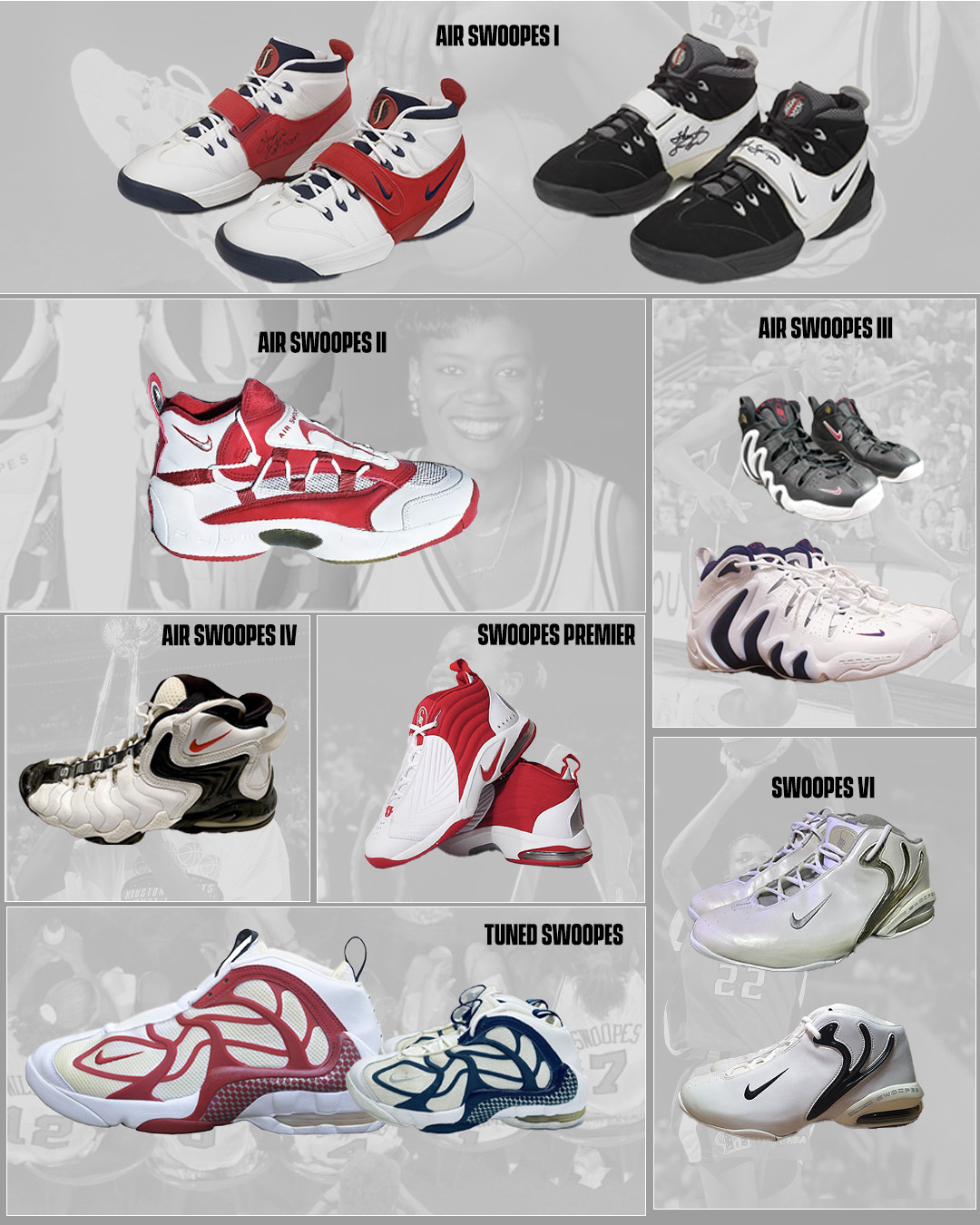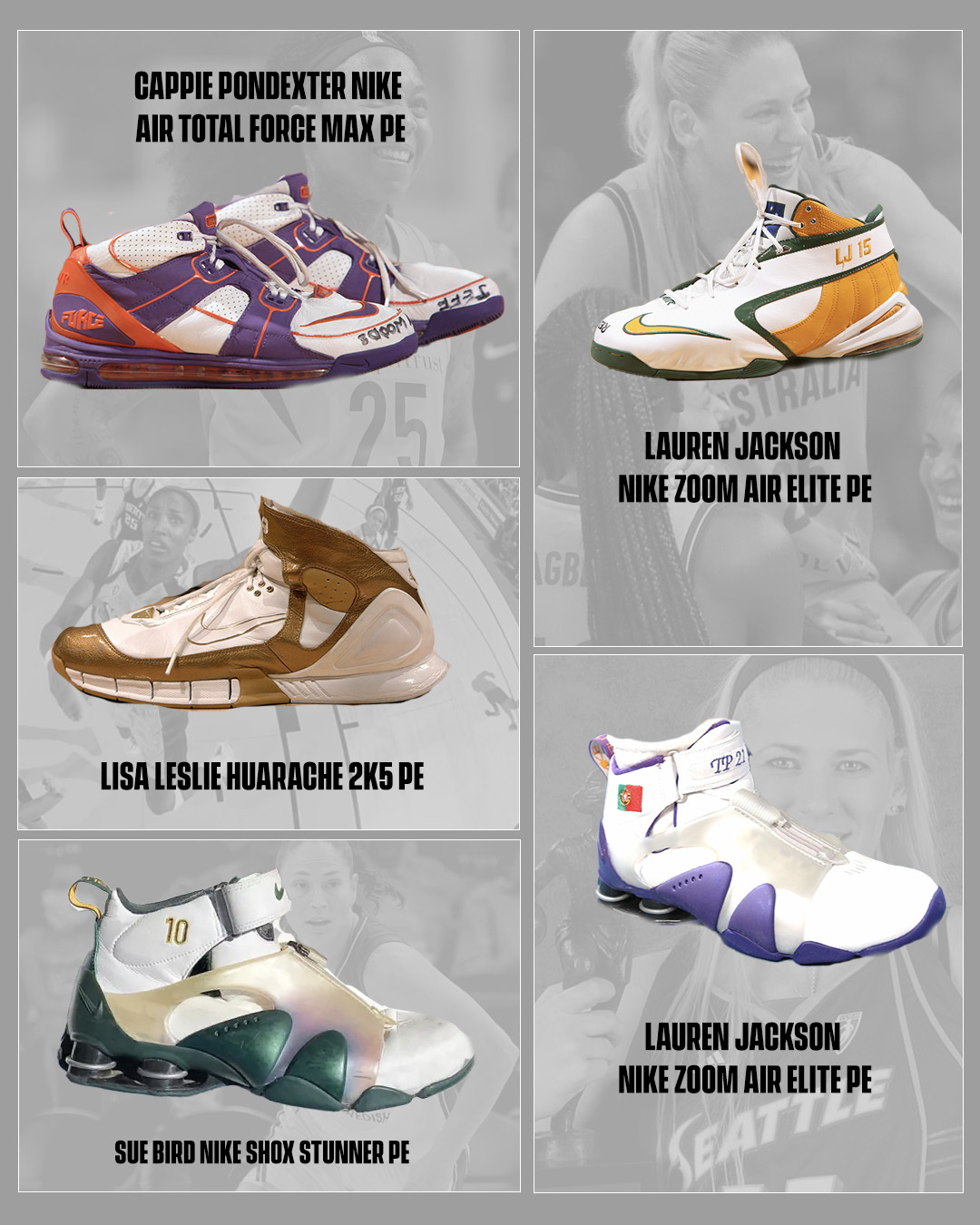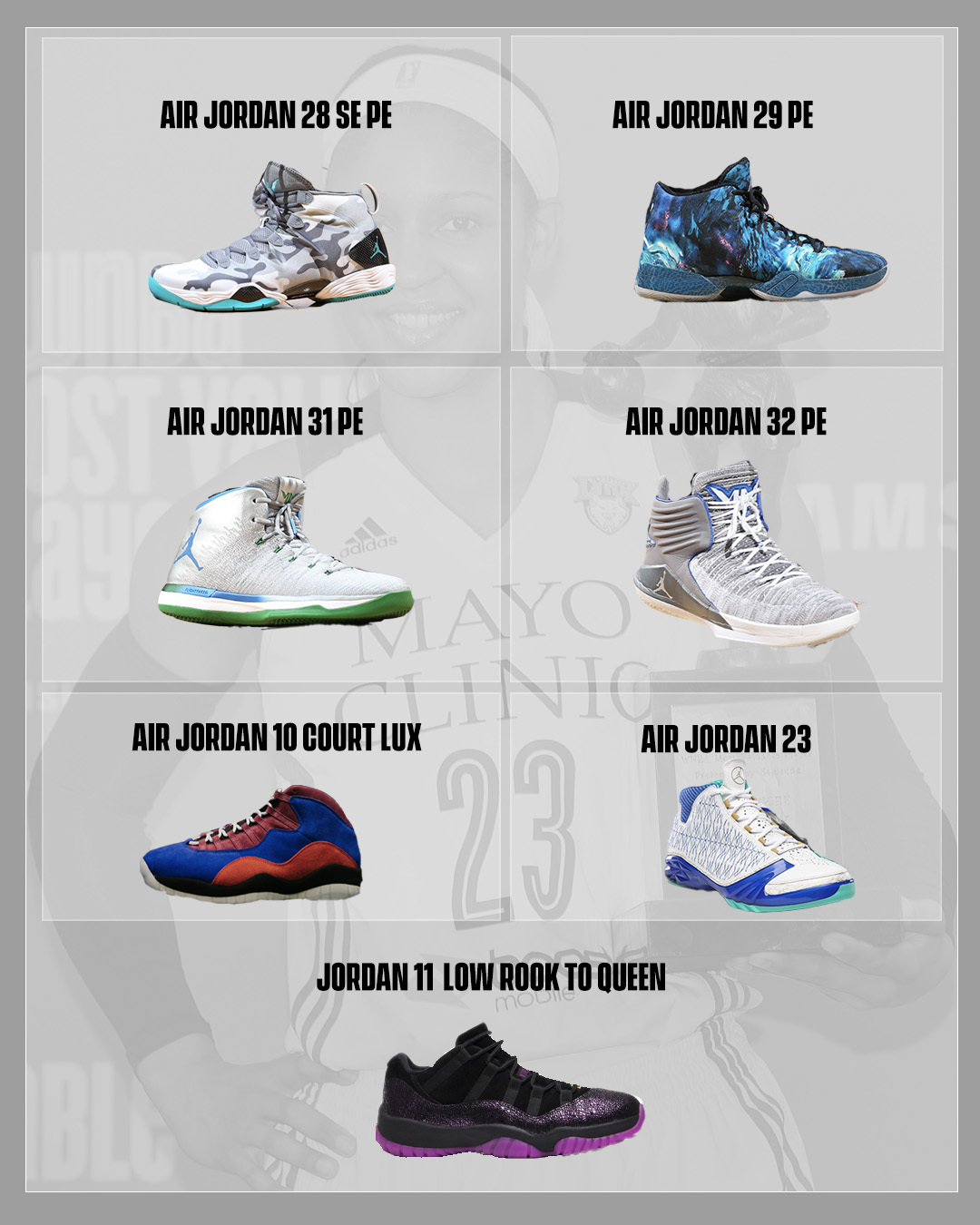The movement started a couple of years before the inception of the W. After winning the ‘93 NCAA Championship with the Texas Tech Lady Raiders—dropping a record 47 points—a 22-year-old Sheryl Swoopes signed with The Swoosh. The future Hall of Famer and four-time WNBA Champion was a surefire lock for the ‘94 USA Women’s National Team. In the midst of their Bronze medal run in the FIBA World Championships, Nike and lead designer Marni Gerber were in the process of making history.
After falling short of expectations in ‘94, a 52-game exhibition schedule was prepared. While the historic group of players including Lisa Leslie, Dawn Staley, Nikki McCray and Katrina McClain prepared for the ‘96 Olympics, Nike released the first-ever women’s signature basketball shoe, the Nike Air Swoopes I. The model was filled with Swoopes’ insights, highlighted by her signature “S” logo on the tongue and rounded heel tabs so she could easily get in and out of the shoes with her long nails.
The red, white and blue colored model would be the first of Swoopes’ seven signature silhouettes, the longest signature run for any women’s basketball player. In the inaugural season of the WNBA, Swoopes would rock the Air Swoopes Zoom III. She’d win the first of her and the Houston Comets’ four-straight championships in the Air Zoom Swoopes. She recorded the first triple-double in League history and won a ‘96 Olympic Gold medal in the Air Swopes II and won the 2000 WNBA MVP in the Air Swoopes IV.
From ‘95 to ‘01, Sheryl Swoopes ushered in a new age of marketability and potential for women and young girls in sports across the country. And in the place of the trail she blazed, others expanded the realm of opportunity.

After witnessing the success of Swoopes first three silhouettes, Nike would welcome a second WNBA athlete to the signature family; Lisa Leslie. With a 101-point high school game continuing to spread the word of her dominance, the USC legend held potential from the hardwood to the runway—signing a modeling contract with the acclaimed Wilhelmina agency before joining the LA Sparks in ‘97.
Fresh off winning Gold at the ‘96 Olympic Games and securing All First-Team honors in her rookie season, Leslie debuted the Nike Total Air 9 during her sophomore campaign in ‘98. Inspired by the lavish aesthetic of Chanel handbags that she grew up idolizing, Leslie’s first and only signature silhouette boasted a quilted leather upper and metallic swooshes that took after her love for silver jewelry. After incorporating Leslie’s design language, Nike outfitted the mid-top with a full-length Total Air cushioning system.
From the Nike Air Max Elite to the Blue Chip II and the Huarache 2K5, the three-time League MVP rocked their marquee models designed in exclusive Sparks colors and inscribed with her “LL9” logo.
While it typically takes anywhere from 18-24 months for a marketing plan and signature shoe to be created and officially released, Swoopes and Leslie dropped buckets in some of the first basketball shoes designed exclusively for women. By ‘98, The Swoosh would bolster its roster even further, releasing Dawn Staley’s signature sneaker, the Nike Zoom S5. Flaunting the first initial of her last name and her jersey number along the supportive strap, the glove-like model would receive a follow-up in the Zoom S5 II in ‘99. In that same year, Cynthia Cooper-Dyke entered the chat after headlining the Nike Air Max Shake ‘Em Up in her rookie season.
Named after her jersey number, the Nike Air C14 witnessed the Houston Comet’s third-straight WNBA Championship and cemented Nike’s stake in the women’s game. Five signature shoes in five years.

To champion its female-led roster, Nike did what they did best, cook up a fire commercial. Not just one, but three. Headlined by a young Kyla Pratt, the circa ‘98 “Little Rascals” showcased three young girls peppering Lisa Leslie, Sheryl Swoopes, Cynthia Cooper-Dyke and Tina Thompson with questions and opinions about their game.
While Nike rolled out the red carpet, Jordan Brand—not even a year into the establishment as its own independent brand underneath Nike—launched its basketball shoe designed and geared exclusively toward women. Releasing it in the same year as the Air Jordan XIII, the Jordan OG shared a similar design language with dimple-stitched sidewalls and a carbon fiber shank in the midsole while the heel was decorated with an embroidered jet-black W.
SLAM 29 cover star Chamique Holdsclaw would revolutionize the turn of the century. As Cooper, Staley, Leslie and Swoopes headlined Air Max and Zoom Air-based cushioning systems, Chamique led the way for the brand’s latest on-court technology, Nike Shox.
The iconic Nike Shox BB4 became a staple for Holdsclaw in ‘01. Her version, however, pulled from a space-themed inspiration, sporting a porous pattern laid across the leather sidewalls that mimicked moon craters. After securing the ‘02 Scoring Title, Holdsclaw held down the debut of her own signature, the Nike Shox Mique II.
Three years later, a future contender for the GOAT title would arise, marking Nike’s sixth women’s signature athlete: Diana Taurasi. The reigning Rookie of the Year entered the ‘05 season with the Nike Air Taurasi in tow, doing damage in UConn and Mercury-based colorways. Her Maserati-inspired signature logo sat proudly along the outer heel above a sea of quilted stitching.

The following season saw DT and The Swoosh run it back, switching from an Air-based cushioning solution to the wildly popular Shox technology. Aside from the orange and purple palettes and “Taurasi” printed insoles, the Nike Shox DT explored a much more reserved approach to the signature solution. Instead, the mid-top model was marketed toward high school teams that often wore matching sneakers in unison. Throughout ‘06, the Shox DT released a myriad of team bank colorways that could easily match with girls’ basketball teams across the country. Yet Taurasi’s second sneaker would be the final women’s-specific signature series released by the brand in nearly two decades.
In the place of signature offerings came a more centralized focus on the brand’s tried-and-true solutions. The ‘02 season saw the Nike Shox Stunner extend a far-reaching dominance. Four-time All-Star Tina Penicheiro frequented an exclusive purple, white and silver colorway with an embroidered Portugal flag while Tina Thompson’s contrasting red pair sported “Cali Girl” in royal blue cursive along the ankle strap.
Both Sue Bird and Seattle Storm teammate Lauren Jackson were known for stockpiling heat in the Pacific Northwest, dicing up the W in PEs of the Zoom Soldier V, and the heralded Huarache 2K4. Lindsey Harding, Deanna Nolan, Tamika Catchings, Bird and Jackson all made the Nike Air Flight Elite a staple in ‘07.

Those reserved colorways weren’t just held for the players. In 2011, Nike showed the entire LA Sparks organization some love to celebrate their 15th season, releasing an extremely limited 24 pairs of the Nike Zoom Hyperfuse in the team’s eccentric color scheme.
That same year, Jordan signed one of the greatest players ever: Maya Moore.
Entering her rookie season with the Minnesota Lynx, Moore headlined the brand’s suave, sleek and equally explosive ethos. During her reign in the W, Moore touted Jordan’s full line of on-court solutions, from the Jordan Fly Wade and the Jordan Super Fly to the Jordan Game shoe; the modern continuation of Michael Jordan’s signature line that’s currently on its 39th iteration. Moore rocked exclusive colorways and textures. The Air Jordan 28 through Air Jordan 32 became a blank canvas for gradients and hues inspired by the Lynx color scheme, marbled, lenticular and galactic patterns and of course her signature logo.
Off the court, the former WNBA MVP explored her taste through the lens of the Air Jordan retro silhouettes. Rich fabrics and colorful palettes filled a number of models inspired by Moore including the Air Jordan 1, Air Jordan X and Air Jordan XI.

Despite the care, dedication and creativity that was poured into Nike and Jordan’s mainstay models, the absence of a leading female presence in the signature basketball space certainly became a point of contention over the years.

Looking to expand your WNBA sneaker knowledge? Read more on how the current legends of the W are creating their own renaissance movement.